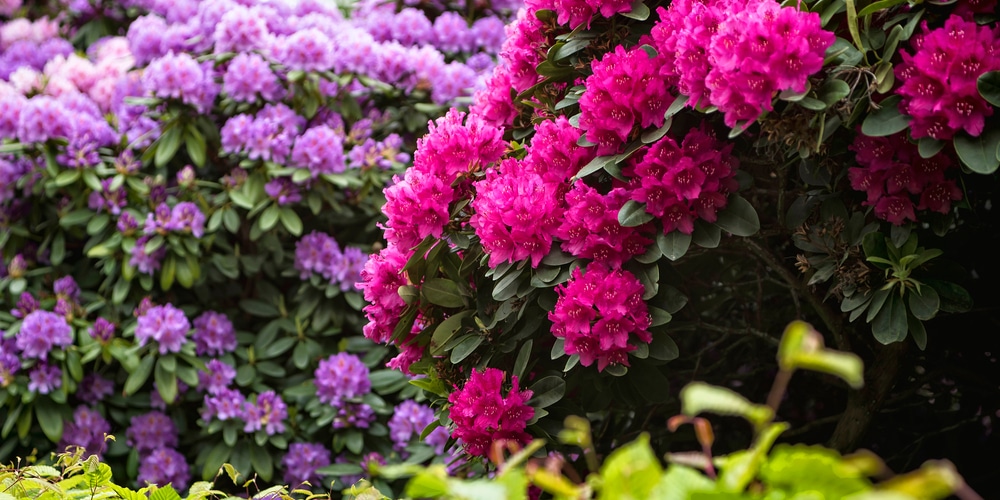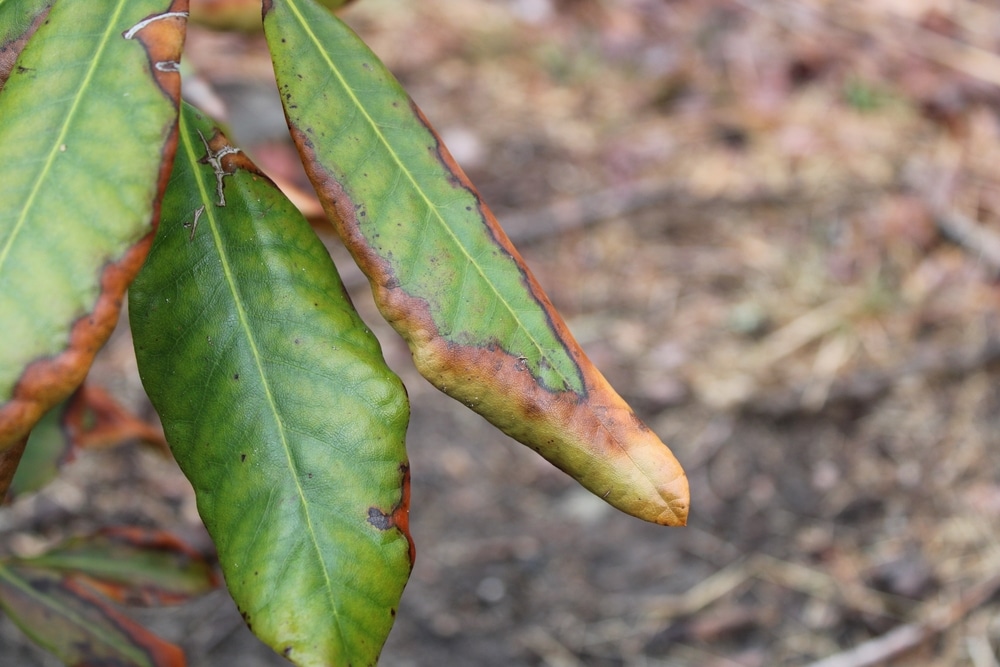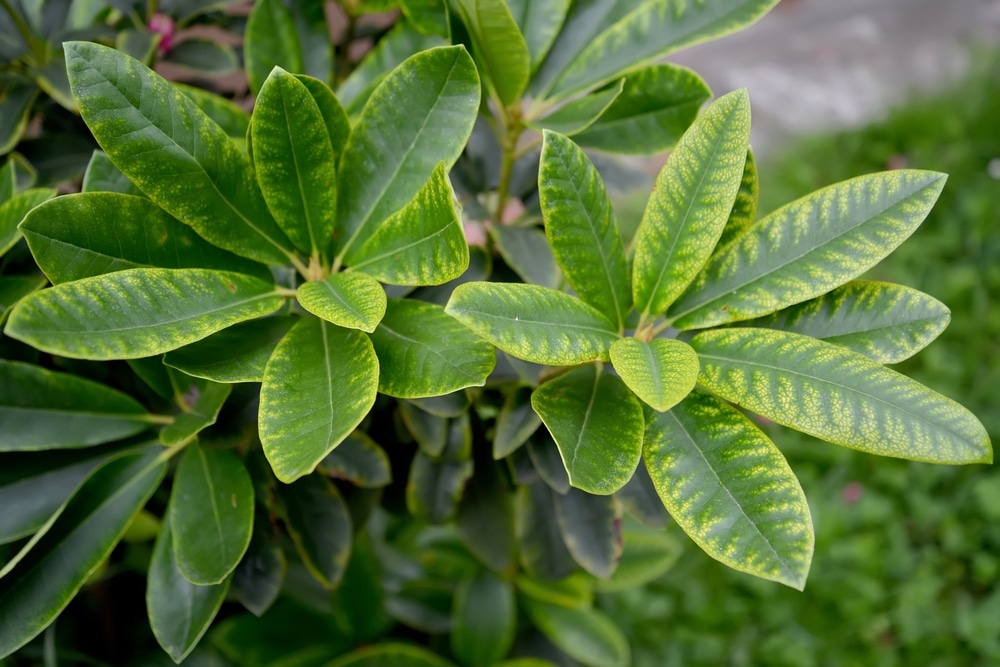Rhododendrons are a widely cultivated shrub and for a good reason. They are relatively easy to take care of and can provide a splash of color in any garden with their large, showy clusters. While they are mostly known for their large, showy flowers, their leaves are also an important part of the plant. The leaves are typically a deep green color, but they can sometimes turn yellow. If your rhodo leaves are yellowing, it could be due to a number of different reasons.
But don’t fret. In this article, we will explore some of the top reasons why rhododendron leaves turn yellow, as well as some solutions for fixing the problem.
A little bit about rhododendrons
Rhododendrons are a part of the Ericaceae family and are related to blueberries, azaleas, and cranberries. There are over 1000 species of rhododendrons that can be found all over the world, including in North America, Europe, and Asia.
Important to note is the fact that these plants require acidic soil in order to survive. As such, they won’t tolerate alkaline soil, and if grown in such conditions, their leaves will simply turn yellow, and the plant will, later on, stop growing and then fail.
If, therefore, you’ve been looking to grow these magnificent plants on your lawn, one of the first and most important steps that you never want to miss out on is to make sure that the soil is indeed acidic.
Also, keep in mind that the plant enjoys being planted in rich, moist soil in an area with partial shade or full sun. Rhododendrons thrive best in an environment that is not too cold nor hot (zones 5-8).
Reasons for rhodo leaves yellowing
Now that we know a little bit more about rhododendrons, let’s explore some of the reasons why their leaves might turn yellow.
1. Natural yellowing
If you have Rhododendron shrubs that are 2-3 years old, and you see the leaves turn yellow and start to fall off just as winter kicks in, this is nothing to be alarmed about.
The yellowing of the leaves is a natural process and is a regular part of the life cycle of Rhodies as they prepare to go into dormancy.
2. Wet soil
Rhododendrons don’t like “wet feet.” In other words, they don’t enjoy having their roots constantly soaked in water. The telltale sign that your Rhodo is having this problem is a yellow discoloration, especially around the leaf veins.
You can check the drainage of your soil by digging a hole about 8 inches deep and 12 inches wide and then filling it with water. Allow the water to drain and then refill it after 12 hours. Time how long it takes for the water to drain.
All the water should be gone after 2-3 hours. If it takes more than 10 hours to drain, then you have a drainage issue.
Solution:
In the case of wet soil due to poor drainage, you can lift the plant and improve the soil structure. Alternatively, you can lift the plant and move it to a better-drained location. It’s best to lift your rhododendrons plants between October and March as this is when they will be dormant.
If the wet soil is the result of overwatering, you will need to change your watering habits. Rhododendrons need approximately 1 inch of water per week, either from rainfall or irrigation.
3. Soil pH
As we mentioned before, rhododendrons need acidic soil to grow properly. If the soil is too alkaline, the leaves will start to turn yellow. It’s a good idea to measure your soil pH so as to make sure that it falls between 4 and 6, as this is the ideal range for Rhododendrons.
You can hire professionals to test your soil for you, or better yet, get a soil pH testing kit and do it yourself if you have an idea of how to do it.
If the pH of the soil turns out neutral or exhibits high acidic levels, then the yellowing might have resulted from using hard water. This is especially true for rhodies that are planted in pots.
Solution:
You can add sulfur to the soil to acidify/lower the pH, even though this is a temporary solution that also fails to work if the soil contains free lime or calcium carbonate. Free lime is typically common in locations that have hard water.
4. Mineral deficiency
A deficiency in certain minerals can also cause rhododendron leaves to turn yellow. The most common minerals that Rhododendrons need are found naturally in soil. In alkaline soils, however, rhodies can’t get enough iron and this results in chlorosis.
A clear sign of this is yellowing in young leaves that have characteristic green leaves. The problem is not caused by a deficiency of iron, rather it’s that the iron becomes chemically bound to the soil if the soil is too alkaline. A deficiency of magnesium can also cause the same problem.
Solution:
For iron deficiency, adding iron chelates can be a good solution. However, it’s quite rare for chlorosis to be the result of a deficiency of iron in the soil.
In the cases of magnesium deficiency, you can use Epsom salts as a temporary solution. It’s best, however, to have the soil tested and then amend it accordingly.
5. Planting too deeply
If you plant rhododendrons too deeply, their leaves will start to turn yellow. It’s recommended that the rootball of the plant be at or slightly below the surface of the soil. If you’re unable to feel the rootball after feeling around the base of the plant, chances are that it’s too deep.
This problem is common for plants that have been transplanted from pots to the ground. When planted too deep, the soil around the roots will smother them, and this may cause yellowing of the leaves as the plant starts to die.
Solution:
If you find that your rhododendron is planted too deeply, the best thing to do is to dig it up and replant it at the correct depth. This is a delicate process, so it’s best to hire a professional if you’re not confident in your abilities. Again, lifting the plant is best done when it’s dormant.
6. Inadequate lighting
Rhododendrons thrive best in bright, dappled sunlight. As such, placing them in an area that’s poorly lit will cause the leaves to turn yellow. This is because the plant isn’t able to produce enough chlorophyll, which is essential for photosynthesis.
In a similar way, if a rhododendron is placed in an area that’s too sunny, the leaves may also start to turn yellow. This is mainly attributed to sunburn – too much of anything is poisonous.
Solution:
If you find that your rhododendron isn’t getting enough light, the best thing to do is to move it to a brighter location. If the plant is in a pot, you can simply turn it so that the leaves are facing the sun.
For a plant that is in the ground, however, you may have to dig it up and replant it in a better location. The same goes for if the plant is receiving too much sunlight.
Rhodo leaves yellowing: Concluding thoughts
There are many reasons why rhododendron leaves might turn yellow. These include, but are not limited to, overwatering, mineral deficiency, planting too deeply, and inadequate lighting.
Luckily, most of these problems have relatively simple solutions. With a bit of trial and error, you should be able to figure out what’s causing the yellowing of your rhododendron’s leaves and fix the problem in no time.


